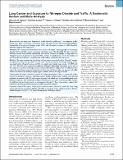| dc.contributor.author | Hamra, Ghassan B. | en_US |
| dc.contributor.author | Laden, Francine | en_US |
| dc.contributor.author | Cohen, Aaron J. | en_US |
| dc.contributor.author | Raaschou-Nielsen, Ole | en_US |
| dc.contributor.author | Brauer, Michael | en_US |
| dc.contributor.author | Loomis, Dana | en_US |
| dc.date.accessioned | 2015-12-04T18:15:52Z | |
| dc.date.issued | 2015 | en_US |
| dc.identifier.citation | Hamra, Ghassan B., Francine Laden, Aaron J. Cohen, Ole Raaschou-Nielsen, Michael Brauer, and Dana Loomis. 2015. “Lung Cancer and Exposure to Nitrogen Dioxide and Traffic: A Systematic Review and Meta-Analysis.” Environmental Health Perspectives 123 (11): 1107-1112. doi:10.1289/ehp.1408882. http://dx.doi.org/10.1289/ehp.1408882. | en |
| dc.identifier.issn | 0091-6765 | en |
| dc.identifier.uri | http://nrs.harvard.edu/urn-3:HUL.InstRepos:23845387 | |
| dc.description.abstract | Background and objective Exposure to traffic-related air pollutants is an important public health issue. Here, we present a systematic review and meta-analysis of research examining the relationship of measures of nitrogen oxides (NOx) and of various measures of traffic-related air pollution exposure with lung cancer. Methods: We conducted random-effects meta-analyses of studies examining exposure to nitrogen dioxide (NO2) and NOx and its association with lung cancer. We identified 20 studies that met inclusion criteria and provided information necessary to estimate the change in lung cancer per 10-μg/m3 increase in exposure to measured NO2. Further, we qualitatively assessed the evidence of association between distance to roadways and traffic volume associated with lung cancer. Results: The meta-estimate for the change in lung cancer associated with a 10-μg/m3 increase in exposure to NO2 was 4% (95% CI: 1%, 8%). The meta-estimate for change in lung cancer associated with a 10-μg/m3 increase in NOx was similar and slightly more precise, 3% (95% CI: 1%, 5%). The NO2 meta-estimate was robust to different confounding adjustment sets as well as the exposure assessment techniques used. Trim-and-fill analyses suggest that if publication bias exists, the overall meta-estimate is biased away from the null. Forest plots for measures of traffic volume and distance to roadways largely suggest a modest increase in lung cancer risk. Conclusion: We found consistent evidence of a relationship between NO2, as a proxy for traffic-sourced air pollution exposure, with lung cancer. Studies of lung cancer related to residential proximity to roadways and NOx also suggest increased risk, which may be attributable partly to air pollution exposure. The International Agency for Research on Cancer recently classified outdoor air pollution and particulate matter as carcinogenic (Group 1). These meta-analyses support this conclusion, drawing particular attention to traffic-sourced air pollution. Citation Hamra GB, Laden F, Cohen AJ, Raaschou-Nielsen O, Brauer M, Loomis D. 2015. Lung cancer and exposure to nitrogen dioxide and traffic: a systematic review and meta-analysis. Environ Health Perspect 123:1107–1112; http://dx.doi.org/10.1289/ehp.1408882 | en |
| dc.language.iso | en_US | en |
| dc.publisher | National Institute of Environmental Health Sciences | en |
| dc.relation.isversionof | doi:10.1289/ehp.1408882 | en |
| dc.relation.hasversion | http://www.ncbi.nlm.nih.gov/pmc/articles/PMC4629738/pdf/ | en |
| dash.license | LAA | en_US |
| dc.title | Lung Cancer and Exposure to Nitrogen Dioxide and Traffic: A Systematic Review and Meta-Analysis | en |
| dc.type | Journal Article | en_US |
| dc.description.version | Version of Record | en |
| dc.relation.journal | Environmental Health Perspectives | en |
| dash.depositing.author | Laden, Francine | en_US |
| dc.date.available | 2015-12-04T18:15:52Z | |
| dc.identifier.doi | 10.1289/ehp.1408882 | * |
| dash.contributor.affiliated | Laden, Francine | |
| dc.identifier.orcid | 0000-0002-2813-2174 | |


